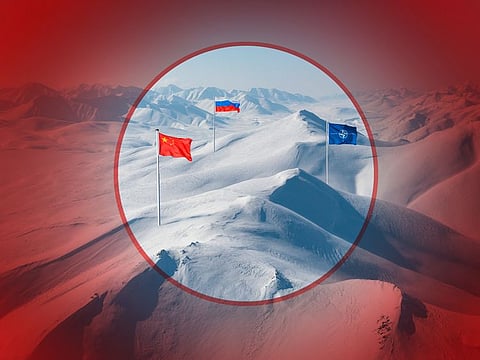Is the Arctic the next Ukraine?
Melting Arctic: a new battleground for resources as Russia, China & Nato assert influence

A decade ago, the Arctic was high on the agenda of Europe’s emerging security concerns. However, after Russia’s accession of Crimea in 2014, the focus shifted to Eastern Europe and the changing geostrategic computation due to planned Nato expansion.
The War in Ukraine since last year has almost pushed the Arctic out of Europe’s security discourse. This disregard for the Arctic as an issue has not ended the serious challenges this global shared space poses and the significant opportunity it offers.
The region north of the Arctic Circle almost entirely consists of frozen water and holds up to nearly 20 per cent of the world’s freshwater resources. For centuries, the harsh climate and hostile temperature has kept the Arctic as one of the very few remaining untapped regions of the world.
But global warming in recent decades is heating the Arctic, and the competition among the global powers to access and control this yet-to-be-unexploited vast region. The fast melting ice caps has opened opportunities for an increasingly divided world.
Under the melting ice, the Arctic has vast oil, natural gas, and mineral deposits. A rough estimate is that the region holds 13 per cent of the world’s oil (90 billion barrels) and 30 per cent of undiscovered natural gas reserves (48 trillion cubic meters).
There are also significant deposits of copper, lithium, nickel, platinum, and rare earth metals. Moreover, the region provides enormous possibilities for producing renewable energy by housing wind and marine turbines.
The fast melting of the ice is also opening new shipping routes through the Arctic Sea. Since 2007, the Northern Sea Routes and channels along the Northwest Passage have become virtually ice-free for extended summertime.
21st Century Suez?
The receding of polar ice may make the Arctic completely free from summer sea ice by 2035. The former US Secretary of State, Mike Pompeo, had said that the Arctic could become the “21st Century Suez and Panama Canals”.
These new shipping routes through the Arctic will be nearly 40 per cent shorter than the current route through Suez Canal for the ships carrying goods between China and Europe.
In 2022, despite war and sanctions, the Northern Sea Routes saw increased traffic. Due to the newly announced Vostok Oil Project, the traffic volume through this route is expected to surge further from 2024.
While the Arctic is gaining greater interest among many countries worldwide, the region is divided among eight countries with territorial rights within the area.
The US, Canada, Iceland, Denmark, Norway, Sweden, Finland, and Russia are Arctic states. Canada was the first country in 1935 to put forward its territorial claim over many land areas in the region, and in 1937, the Soviet Union followed with its own.
Territorial privileges
Each Arctic country has claimed territorial privileges over some parts but many of their claims have been contested, leading to several disputes. These Exclusive Economic Zones disputes have been more often settled through the UN Convention on the Law of the Sea, or UNCLOS (though the US still is not a party).
The eight Arctic countries have established the Arctic Council since 1996. Besides the member states, the Arctic Council has 38 observers, consisting of many large European countries, China, India, and several Intergovernmental, interparliamentary, and non-governmental organisations.
Though this intergovernmental forum helps foster cooperation in the region on issues like the environment, its mandate is limited and not legally binding in nature.
The existing framework for cooperation in the Arctic region is insufficient to meet the security challenges emerging due to increased sea traffic and large-scale military build-up. The US and its Nato allies are showing greater concerns due to Russia’s expanding military activities, and the War in Ukraine has further added to their worries.
Russia has already reactivated over 50 Soviet-era military outposts and upgraded ten radar stations in the Arctic region. Moscow is also strengthening its navy’s northern command, which covers the Arctic, by adding more advanced battleships.
The US and its allies are also deploying their fifth-generation fighter jets in the Arctic, and its submarines have increased their patrolling.
In 2018, Nato conducted one of its largest military exercises, Trident Juncture’ in northern Norway. Finland’s joining of Nato and Sweden’s possibly formally joining the alliance soon have increased the strength of Nato in the region.
Increased activity in polar region
Russia and Nato are conducting regular large military exercises in the Arctic — Russia did ‘Umka-2021’, and Nato responded with its ‘Cold Response’ in 2022; the US, under the Biden administration, has started investing massively increasing its military capabilities in the Arctic, while Russia is becoming more assertive.
The contestation in the region is no more limited to the Arctic countries. The Arctic has become somewhat crowded due to China’s entry.
Beijing has emerged as an important player in key areas of Arctic affairs, from exploring natural resources to northern shipping to environmental protection. China defines itself as a ‘Near Arctic State’ and has substantially accelerated its engagement in the region in recent years.
China has sent nearly a dozen scientific expeditions to the Arctic and plans to build nuclear-powered icebreakers to connect the Arctic routes to its Belt and Road Initiative.
In its quest to become a global superpower, its navy is also searching for faster access to the Atlantic. China has even suggested that the resources of the Arctic should be shared with all the countries proportional to their population.
China’s emergence as an active player in the geopolitical landscape of the Arctic removes the possibility of Russia being isolated in the region.
It is only a matter of time before the Arctic becomes another zone of conflict between the two power blocs in an increasingly bipolar world.
Sign up for the Daily Briefing
Get the latest news and updates straight to your inbox




